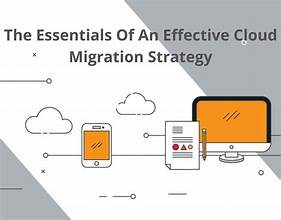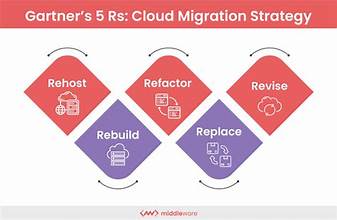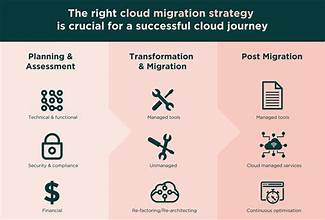
In today’s digital era, cloud migration has become a crucial strategy for businesses looking to enhance their operational efficiency and scalability. As we approach 2024, optimizing your cloud migration strategy is more important than ever. This article will explore key trends and insights to help you navigate and refine your cloud migration efforts effectively.
1. Understanding Cloud Migration
Cloud migration involves moving data, applications, and other business elements from on-premises infrastructure to cloud-based environments. The primary motivations for cloud migration include cost reduction, improved scalability, enhanced performance, and greater flexibility. However, a successful migration requires meticulous planning and execution.
2. Key Trends in Cloud Migration for 2024
A. Increased Adoption of Multi-Cloud and Hybrid Cloud Strategies
In 2024, many businesses are shifting towards multi-cloud and hybrid cloud environments. These strategies allow organizations to leverage services from multiple cloud providers and combine public and private cloud solutions. The benefits include:
- Avoiding Vendor Lock-In: By using multiple cloud providers, businesses can avoid dependency on a single vendor and have more flexibility.
- Optimized Cost Management: Multi-cloud strategies enable organizations to choose the best pricing models and services from different providers.
- Enhanced Resilience: Distributing workloads across multiple clouds improves disaster recovery and system resilience.
B. Emphasis on Cloud Security and Compliance
As data breaches and cyber threats become more sophisticated, cloud security remains a top priority. In 2024, businesses will focus on implementing robust security measures and ensuring compliance with regulations. Key practices include:
- Implementing Zero Trust Security Models: Adopting a zero-trust approach ensures that every access request is verified, regardless of the user’s location or device.
- Regular Security Audits: Conducting frequent security assessments helps identify and address vulnerabilities.
- Compliance with Standards: Adhering to industry standards and regulations, such as GDPR and HIPAA, ensures data protection and legal compliance.
C. Leveraging AI and Machine Learning for Optimization
Artificial Intelligence (AI) and Machine Learning (ML) are transforming cloud migration strategies. These technologies provide valuable insights and automation capabilities, including:
- Predictive Analytics: AI tools can forecast future cloud usage and performance, helping in capacity planning and cost optimization.
- Automated Migration Tools: ML algorithms streamline the migration process by automating routine tasks and minimizing human error.
D. Focus on Cloud-Native Architectures
Cloud-native architectures, which utilize microservices, containers, and serverless computing, are gaining traction. These architectures offer benefits such as:
- Increased Flexibility: Cloud-native solutions enable rapid development and deployment of applications.
- Improved Scalability: Containers and serverless computing scale automatically based on demand, optimizing resource usage.
3. Best Practices for Optimizing Cloud Migration
A. Conduct a Comprehensive Assessment
Before migrating to the cloud, conduct a thorough assessment of your existing IT infrastructure. Identify applications, data, and workloads that are suitable for cloud migration. Consider factors such as:
- Application Compatibility: Evaluate whether applications are cloud-ready or need modifications.
- Data Sensitivity: Classify data based on sensitivity and compliance requirements.
B. Develop a Clear Migration Strategy
Create a detailed migration plan that includes:
- Goals and Objectives: Define the purpose of the migration and expected outcomes.
- Timeline and Milestones: Establish a realistic timeline with key milestones.
- Risk Management: Identify potential risks and develop mitigation strategies.
C. Choose the Right Cloud Service Providers
Selecting the right cloud service providers is crucial. Consider factors such as:
- Service Offerings: Ensure that the provider offers the services and features that align with your needs.
- Performance and Reliability: Evaluate the provider’s performance metrics and reliability.
- Support and SLAs: Review the support options and Service Level Agreements (SLAs) offered.
D. Implement Effective Change Management
Successful cloud migration involves managing change effectively. Key practices include:
- Stakeholder Engagement: Involve all relevant stakeholders in the migration process to ensure buy-in and support.
- Training and Support: Provide training to staff on new cloud technologies and processes.
- Continuous Monitoring: Monitor the cloud environment post-migration to ensure performance and address any issues.
4. Measuring Success and Continuous Improvement
After migration, evaluate the success of your cloud strategy by measuring:
- Performance Metrics: Assess performance improvements, cost savings, and scalability.
- User Feedback: Gather feedback from users to identify any issues or areas for improvement.
- ROI Analysis: Analyze the return on investment to determine the financial benefits of cloud migration.
Conclusion
Optimizing your cloud migration strategy for 2024 involves staying abreast of emerging trends and adopting best practices. By leveraging multi-cloud and hybrid strategies, focusing on security and compliance, utilizing AI and ML, and embracing cloud-native architectures, businesses can achieve a seamless and efficient cloud migration. Implementing a comprehensive assessment, developing a clear strategy, choosing the right providers, and managing change effectively will pave the way for successful cloud adoption and long-term success.









